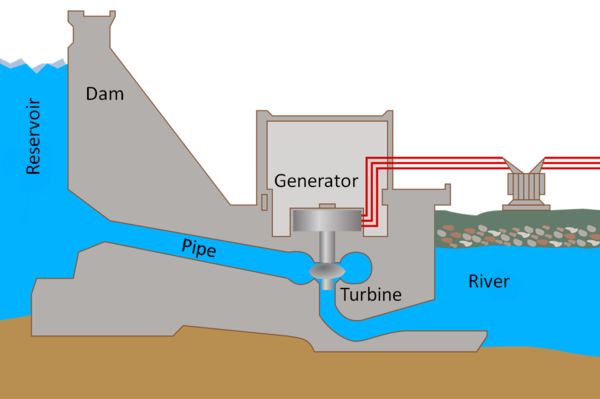Contents
Key Stage 3
Meaning
Hydroelectricity is an energy resource that uses the water flowing in rivers to generate electricity.
About Hydroelectricity
- Hydroelectricity is a renewable energy resource.
- Hydroelectricity has energy in the gravitational potential energy store of water that is flowing downhill.
Power
Hydroelectricity can be used to generate electricity.
| A diagram of a hydroelectric dam. |
- 1. Water flowing down a river is held back by a dam making a large reservoir.
- 2. Some water is allowed through pipes to flow downhill.
- 3. This water turns a turbine as it falls.
- 4. The turbine causes a generator to spin.
- 5. The generator makes an electrical current.
Advantages
- Reliable source as it is built in places that do not suffer drought.
- Power provided can change at a moments notice by allowing more water through the turbines.
- Low running costs and no fuel cost.
Disadvantages
- Expensive to build.
- Require the flooding of a large area of land.
- Destroys habitat of some creatures.
- Blocks the migration of some river species.
- Can only be built in certain locations.
Key Stage 4
Meaning
Hydroelectricity is an energy resource that uses the water flowing in rivers to generate electricity.
About Hydroelectricity
- Hydroelectricity is a renewable energy resource.
- Hydroelectricity has energy in the gravitational potential energy store of water that is flowing downhill.
Power
Hydroelectricity can be used to generate electricity.
| A diagram of a hydroelectric dam. |
- 1. Water flowing down a river is held back by a dam making a large reservoir.
- 2. Some water is allowed through pipes to flow downhill.
- 3. This water turns a turbine as it falls.
- 4. The turbine causes a generator to spin.
- 5. The generator makes an electrical current.
Advantages
- Reliable source as it is built in places that do not suffer drought.
- Power provided can change at a moments notice by allowing more water through the turbines.
- Low running costs and no fuel cost.
Disadvantages
- Expensive to build.
- Require the flooding of a large area of land.
- Destroys habitat of some creatures.
- Blocks the migration of some river species.
- Can only be built in certain locations.
References
AQA
- Hydroelectic power, page 50, GCSE Combined Science Trilogy; Physics, CGP, AQA
- Hydroelectric power, page 177, GCSE Combined Science; The Revision Guide, CGP, AQA
- Hydroelectric power, page 24, GCSE Physics, Hodder, AQA
- Hydroelectric power, page 279, GCSE Combined Science Trilogy 1, Hodder, AQA
- Hydroelectric power, page 52, GCSE Physics; The Complete 9-1 Course for AQA, CGP, AQA
- Hydroelectric power, pages 18, 20, GCSE Physics; The Revision Guide, CGP, AQA
- Hydroelectric power, pages 32-3, 41, GCSE Physics; Student Book, Collins, AQA
- Hydroelectric power, pages 38-39, GCSE Physics; Third Edition, Oxford University Press, AQA
Edexcel
- Hydro-electricity, page 161, GCSE Combined Science; The Revision Guide, CGP, Edexcel
- Hydro-electricity, page 29, GCSE Physics; The Revision Guide, CGP, Edexcel
- Hydroelectricity, page 326, GCSE Combined Science, Pearson Edexcel
- Hydroelectricity, page 44, GCSE Physics, Pearson Edexcel
